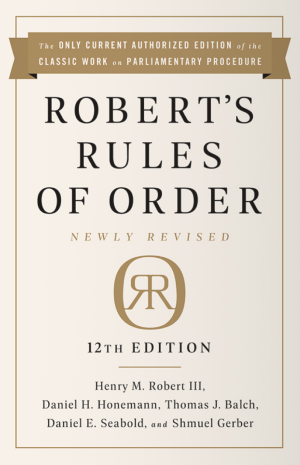Click on a question to expand or collapse.
Also, be aware that your organization's governing documents, including
any special rules of order, bylaws, and statutes, take precedence over
Robert's Rules of Order.
These answers do not take those documents into account.
"RONR" - which stands for "Rules of Order Newly Revised".
The only official version is this one. Because it is comprehensive
and is over 700 pages, it is meant for reference and not to be read cover-to-cover (unless
you are studying to become a parliamentarian). If you want to
know why it is so big, feel free to ask me sometime and I'll be
happy to explain!
The 12th edition is the current one. RONR is revised every ten years, and the next edition is not expected to be released until 2030.


If you want a very short and very readable version, Robert's Rules of Order In Brief is highly recommended:

Actually, RONR does not allow the chair to do that.
This is a common situation, but one of the
fundamental principles of RONR is that "majority rules".
Generally speaking, that means that the majority has the
final say on all questions. As chair, you can rule motions
"out of order" for certain specific reasons. See RONR §39
for the list. But even then, any two members can "appeal
from the decision of the chair", which takes the question
out of your hands and vests it in the assembly for vote.
Additionally, attempting to shut down motions is the single
greatest cause of division and dissention in most assemblies.
My advice is to let the motion be made, debated, and voted upon.
Bad motions will generally be voted down by your membership.
And if the motion is not voted down, maybe it wasn't so bad
after all.
Unfortunately, this strategy may consume valuable meeting
time. The way to minimize the time lost is to assure that
your governing documents have a limitation on debate. And that
the limit is enforced strictly.
.

